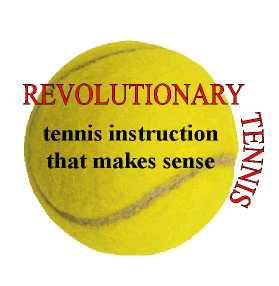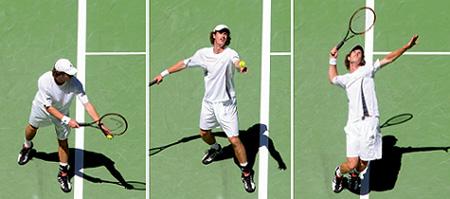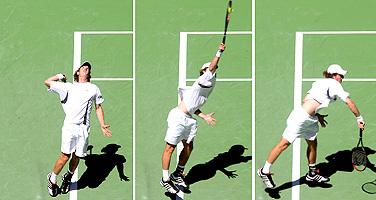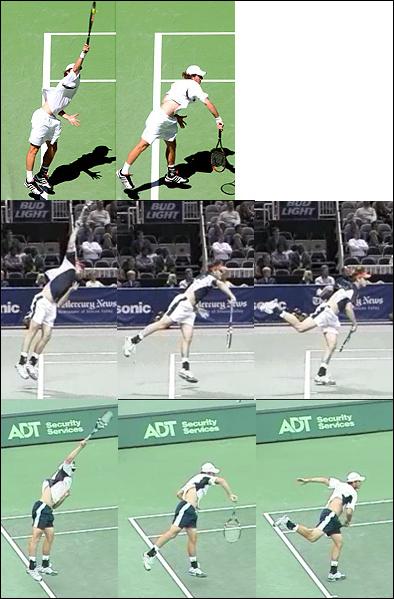Revolutionary Tennis |
||
Tennis Instruction That Makes Sense |
||
Head-On
An analysis here of Andy Murray's serve by Vic Braden begs looking into. First what Vic wrote. Andy Murray's Serve by Vic Braden, Photos by Tommy Hindley/Professional Sport, in TENNIS magazine, October 2006 Nineteen-year-old rising star Andy Murray of Scotland has assaulted the rankings in the last two years, moving nearly 500 spots to his current position inside the Top 40. Solid in every aspect of his game, Murray uses his serve to dictate play right from the get-go. And with a few minor changes, he could make it even better.
1. This is a typical stance for most players. It has no significance as far as racquet acceleration and power— each player simply has his or her own way of beginning to focus on the serve. One note: When my partner, Dr. Gideon Ariel, and I analyzed subjects who used this stance, with the racquet extended, there was an increase in the activity in their trapezius (neck and shoulder) muscles. Some players actually got a little stiff using this method. That's why baseball pitchers shrug their shoulders and exhale to relax the muscles before throwing. 2. Notice that Murray's tossing hand is nearly parallel to the baseline rather than extended toward his opponent. This causes his body to coil [the back shoulder(s) coils on its own, the smaller body part, tossing hand, does not make the larger one move; tossing parallel to the baseline doesn't have to lead to body coil], and it's the uncoiling of the body in a particular sequence from the ground up that generates racquet speed [then why did one of Vic's coaches at his old Tennis College served 124 mph from his knees - more on this later]. That sequence is called the "kinetic chain." Notice also that Murray's dominant arm is extended backward. Many players think they should look like the classic serving trophy, with the hitting elbow tucked way down behind them. But that trophy designer must have had a pitiful serve [the trophy position he rails about is in photo #3, not #2, but the elbow is not "tucked way down" behind the model on the classic serving trophy as well]. 3. At this point, Murray brings his back foot up toward his front, which momentarily stops him from uncoiling his body. He relies on loading the muscles in his upper body rather than generating a complete kinetic chain. His knees are bent to activate a forward and upward movement. While the knee bend is an initiator of the kinetic chain, in our research we found that the knee bend alone was not a huge factor in serve speed and generated less than 10 m.p.h. for most subjects.
4. Here is where Murray fails to maximize his racquet-head speed. His body isn't going as forward and upward as it could be. He tosses the ball farther back than, say, Andy Roddick does. In our research center, we found that the greatest racquet speed was produced when the player's upper arm was going up and forward toward the net, as in a baseball pitch. Murray's upper arm is traveling more upward than forward, which will limit his speed [the arm looks pretty forward to me, but in reality Braden is arguing for his low ball toss idea, i.e. low toss makes you swing forward to "prove" his point of view whereas a higher toss he believes means you reach upward more than forward]. 5. Murray makes contact with the ball at the peak of the toss, which has major advantages in serving percentages. One or two inches in height can often mean the difference between an ace or a ball that hits the tape. Andy continues to uncoil his body, which helps to increase racquet-head speed. Note that Murray's feet have left the ground. If you jump to hit the ball before the upper arm has achieved maximum speed, you'll lose power. This is not true if the ball is tossed out front and the server is pulled off the ground when he reaches for it. 6. Murray has one foot behind the baseline when he lands. (Roddick lands more than 2 feet inside the baseline.) It's important to get the toss as far out in front as you can. As Murray's game continues to improve, I think you'll see him tossing the ball farther out toward the net to maximize racquet-head speed, while remaining properly balanced to attack the net or play the point out from the baseline. This has not been a very objective look at Murray's serve. Vic Braden tries to graft onto this analysis his promotion of the parallel toss arm to coil the body like a baseball player, the low toss, alleged science findings on knees bending adding 10 mph to the serve, his research center, and one of his self described "myths" of the trophy look he so clearly misunderstands (see Step 12 trophy here). Nothing has been very helpful for Andy Murray or tennis magazine's reader, it's all been about Vic Braden. Now let's really compare what's going on here
What would be helpful to Murray is the comparison of upper body position at the contact point. Roddick remains decidedly more turned at this point, his front arm is well tucked in close to the body, whereas Murray's chest is more open to the net. Murray is hauling ass on the serve, which is common today, instead of trying to remain turned for as long as possible through the contact. Finally, it is unconscionable Braden omitted the photograph of Murray landing while telling you what happened, and then comparing it to Roddick without his own photo. It is clear to any real tennis player, pro or amateur, that Murray will not have "one foot behind the baseline when he lands. (Roddick lands more than 2 feet inside the baseline.)" If Murray lands one foot behind the baseline out of this serve I'd love to see the proof, it would be news to me. Was Braden saying Murray has one foot inside the baseline when landing whereas Roddick has two and it's all a series of typos on tennis mag's part? That would be even sloppier. Still, Murray lands with 2 inside the baseline, though perhaps the second one doesn't land as far inside as Roddick's second foot. And if it's not a series of typos, is Roddick really "more than 2 feet inside the baseline" when he lands? The explanation to Roddick's body form in these pictures is upcoming in Step 12, part 5 the Incredible uPness of Contact. Murray's serve looks good, he does not seem exaggerated at any point or trying to max out where nothing's really there. His stance looks to be too wide, which encourages the pinpoint move of the feet, which then may lead to a more forward movement of the body as a whole during the serve as opposed to upward. Said forwardness is evidenced at his contact point with his torso facing the net. That's it. |
||
|
|
||||||||||||||||||||||||||||||||||||||||||||||||||||||||||||||



 In photo #4 Vic claims Murray "tosses the ball farther back than, say, Andy Roddick does" and "Murray's upper arm is traveling more upward than forward." In these stills taken off of simple movie clips from everyman's resource at tennisone.com you can clearly see this is not the case in either claim, and I include two views of Roddick to be fair (1st is at contact, 2nd after). Murray is tossing the ball well out in front and his upper arm travels more forward than upward when comparing with Roddick's contact pic and not the other way around.
In photo #4 Vic claims Murray "tosses the ball farther back than, say, Andy Roddick does" and "Murray's upper arm is traveling more upward than forward." In these stills taken off of simple movie clips from everyman's resource at tennisone.com you can clearly see this is not the case in either claim, and I include two views of Roddick to be fair (1st is at contact, 2nd after). Murray is tossing the ball well out in front and his upper arm travels more forward than upward when comparing with Roddick's contact pic and not the other way around.